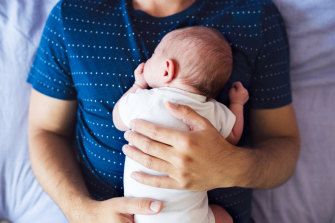Only half the fathers eligible for taxpayer-funded paid parental leave are taking it in a choice the government says shows they’re opting to lose the benefit instead of using it, but which economists say demonstrates the scheme isn’t generous enough.
Impact Economics’ Angela Jackson says the government would be “squibbing it” if it fails to learn lessons from overseas that parental leave must offer more time and more money for Australia to get closer to equal take-up between mothers and fathers.
Treasurer Josh Frydenberg and Social Services Minister Anne Ruston are working to serve up further budget measures for women’s safety and economic security.Credit:Eddie Jim
Treasurer Josh Frydenberg has pledged the pre-election budget at the end of the month will contain more money and measures to support women’s economic security, safety and health. Business figures, unions, economists and early childhood advocates have called for the government to make its paid parental leave scheme more generous to both mothers and fathers.
At the moment, primary carers – overwhelmingly mothers – can receive 18 weeks’ leave at the minimum wage through Centrelink, plus any entitlement their work offers. Dads and partners can take a fortnight at the same minimum wage rate of $772.60 a week.
New government data obtained by The Sydney Morning Herald and The Age shows in 2020-21 there were 168,167 women who received taxpayer-funded parental leave pay.
In the same year, 89,784 people used the dad and partner pay leave scheme – just over half the number of mothers on leave. A government spokesperson said this shows that “dads already opt to lose it rather than use it”.
Grattan Institute chief executive Danielle Wood said the poor take-up more likely reflected the leave on offer being too short.
“Either it’s so small that it’s not on people’s radars or even if they are aware of it, it’s not worth it to navigate the system and deal with Centrelink,” she said.
The experience overseas showed that if fathers were offered more leave, more of them would take it. In Quebec, the proportion of new fathers taking leave jumped to 80 per cent after it began offering them five paid weeks. Across the rest of Canada where the leave scheme is less generous, just 15 per cent of fathers use it.
Other countries with very high take-up include Iceland (20 weeks paid leave), Norway (15-19 weeks) and Spain (16 weeks).
“As take-up starts to rise you get the peer group effect where men see their friends doing it and employers start to expect it,” Ms Wood said.
Only half the fathers eligible for taxpayer-funded paid parental leave are taking it.Credit:iStock
“But you need some sort of incentive for men to be able to do this. Two weeks has been shown not to be sufficient for families.”
Dr Jackson, the lead economist for Impact Economics, says many families wouldn’t be able to afford the drop in income down to the minimum wage.
“Even an average wage rather than the minimum wage would make quite a big difference in terms of whether people see it as feasible to take it up or not,” Dr Jackson said.
“It is true that Australian dads aren’t taking up some of the least generous pay parental leave in the world. But it would be squibbing it not to look overseas where they have succeeded in getting dads to take parental leave, and increase our leave payments for new dads.”
“Either it’s so small that it’s not on people’s radars or even if they are aware of it, it’s not worth it to navigate the system”
As with paying superannuation on parental leave, which the Herald and The Age revealed the government won’t do, the private sector is leading the way on time off for new fathers. Workplace Gender Equality Agency data shows three in five businesses with 100 or more employees offer parental leave on top of the government’s scheme and increasingly this is available to women and men.
The taxpayer-funded schemes cost the budget $2.4 billion a year, less than half the average spend in other similar countries.
The government data shows about 10 per cent of eligible women are taking advantage of new flexibility added into the system in mid-2020.
Under the changes, parents still have to take the first 12 weeks of taxpayer-funded leave in a block after their baby is born, but the remaining six weeks can be taken in small amounts anytime before their child turns two. For instance, a mother returning to work part-time could use it at a rate of one day a week to supplement her income.
More than 13,800 women opted to do this in 2020-21.
Social Services Minister Anne Ruston said the changes had responded to the needs of new parents.
“We encourage all new parents to make the most of the parental leave entitlements that the government offers in a way that best suits their family,” she said.
Mr Frydenberg said the March 29 budget would include another women’s budget statement.
“Our government knows that every household is different. There is no ‘one size fits all’ in the policy response,” he told the Future Women summit.
“But we know that women and families need freedom of choice and flexibility at work.”
The Greens announced on Tuesday a policy to offer families 26 weeks of parental leave, split into six weeks use-it-or-lose-it for each parent and a further 14 weeks to be used as they chose. This would be paid at a parent’s full wage, plus superannuation, up to $100,00pa.
Labor is yet to announce its paid parental leave policy.
The Morning Edition newsletter is our guide to the day’s most important and interesting stories, analysis and insights. Sign up here.
Most Viewed in Politics
From our partners
Source: Read Full Article

